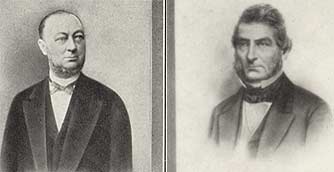
Page 15

The South Side Railroad bought the stock of the New York and Flushing (though the two lines were never fully consolidated) and then bought the Hunter's Point and South Side Railroad, which was consolidated with it in 1872. This connection was used only for freight. It is the present Montauk Division trackage from Bushwick junction to Long Island City. The first freight terminal of the South Side Railroad was located on the point of land at Linden Hill, between Maspeth and Newtown Creeks, known as Furman's Island. In 1874, when Poppenhusen became President of the South Side Lines, the operation of dummy engines from Bushwick through the streets of Brooklyn was discontinued and trains were run over the Hunter's Point and South Side to the Long Island Railroad terminal at Long Island City.
Oliver Charlick, the President of the Long Island Railroad, probably wishing to forestall any attempt of the South Side Railroad to extend its line east from Patchogue, built the Sag Harbor Branch in 1870. This Branch insured his obtaining all of the traffic of the east end of the Island for the Long Island Railroad. This Branch left the Main Line at Manor and went south to Moriches Station (now Eastport) and thence east to the Hamptons and Sag Harbor; when built there were no stations between Good Ground and Southampton, nor was there a stop at Watermill, and Quogue Station was over a mile west of its present location.
The first line to Rockaway was, as has been mentioned, that constructed by parties interested in the South Side Railroad, and subsequently taken over by that railroad.
Schodack Brook was carried under an embankment by means of three culverts which were incapable of carrying off the increased volume of water. The water had undermined this embankment, but the tracks were held up by the frozen ground. The light wooden coach cleared the dangerous spot, but the engine broke through, and turned the coach upside down. Engineer James Scott, of Hempstead, Brakeman Carman, and two other officials were killed in this accident, which was known as the "Southern Railroad Disaster" at Woodfield, L.I. The engine in this disaster was almost completely wrecked by an explosion of the boiler. It was one of those old engines with the water tank built around the boiler, and a large flywheel on the side.
In November, 1874, the New York and Hempstead Railroad was foreclosed and, in July, 1875, The Southern Hempstead Branch Railroad Company was formed to take over the road. After the big accident only a single train a day was run over the road, and in May, 1879, the last train was run, Receiver Sharp having decided that it was unprofitable, as the two roads entering Hempstead from the north were sufficient to carry the traffic. The rails were in place for many years afterwards, and hopes were entertained of opening the line again. But these hopes were never to be realized, for when this section was again served by a railroad, a somewhat different route was chosen. It remains today as an abandoned line, the bondholders having never been able to dispose of it. It may still be traced by the embankments and cuts, with ties and timbers still in place in many portions.
The original South Side Railroad had no freight terminal on the East River and was dissatisfied with running through the streets of Brooklyn by dummy engines. Accordingly, it organized the Hunter's Point and South Side Railroad Company in 1870, which, two years later, built from Bushwick junction along Newton Creek to a junction with the old New York and Flushing Line, near Penny Bridge, and thence over that line to the old terminal in the lumber yard south of the Long Island terminal.

Conrad Poppenhusen and Oliver Charlick, colorful LIRR presidents who figured prominently in the railroad's history.
Updated
©2001 The Composing Stack Inc. All right reserved